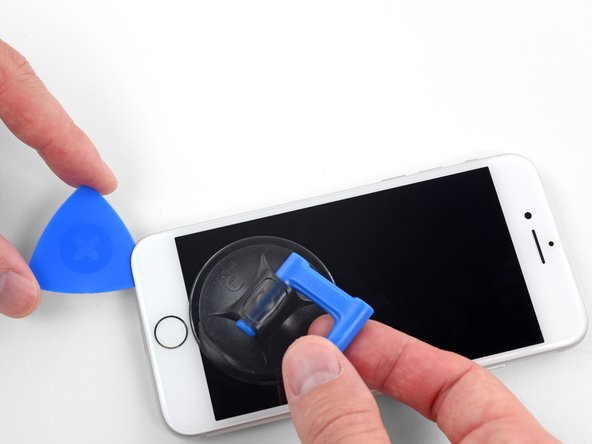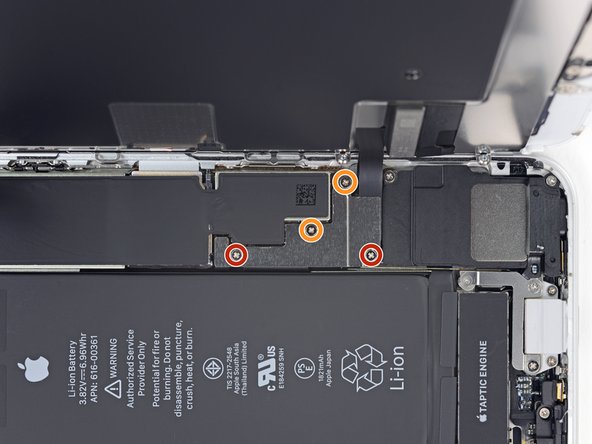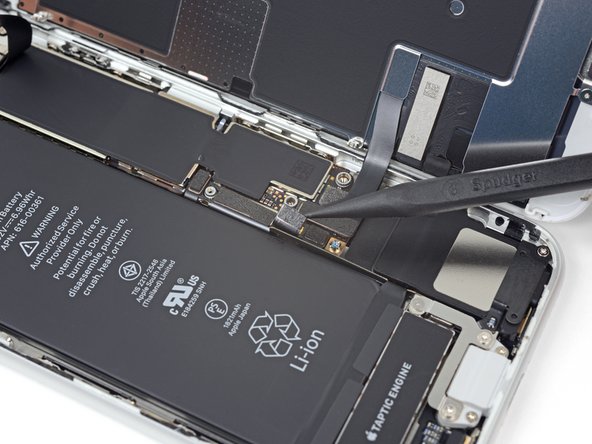iPhone SE 2020 LCD and Digitizer Replacement
Duration: 45 minutes
Steps: 44 Steps
Pass the original home/Touch ID sensor over to the new display with care—it's the secret sauce for keeping everything working smoothly.
Ready to tackle a screen replacement like a pro? Grab our fix kit and breeze through this quick guide to swap out your iPhone’s whole screen! If you’re feeling a bit more adventurous, this guide is your go-to for replacing just the LCD and digitizer assembly for the iPhone SE 2020 (that’s the essential front panel). Just a heads-up: you’ll need to transfer some key components from your old screen to the new one, including the front-facing camera, earpiece speaker, LCD shield plate, and home button assembly. And don’t forget—it's super important to carefully move the original home/Touch ID sensor to the new display for everything to work smoothly. Just a little reminder: the solid-state home button is paired with its original logic board by Apple, so swapping it out will leave it hanging. If you find yourself stuck at any point, just schedule a repair and let the pros handle it!
Step 1
Before you get started, make sure your iPhone battery is below 25%. Lithium-ion batteries are not fans of surprise pokes—charged ones can go out with a bang.
Turn off your iPhone before you begin taking things apart. Trust us, your phone will thank you.
Cracking open your iPhone’s display will break its waterproof seal, so keep some new seals handy if you want to stay splash-proof. If you skip replacing them, just be extra careful around liquids when your phone is back together.
- Take out the two 3.5 mm pentalobe screws chilling on the bottom edge of your iPhone.
Step 2
Pushing your opening pick in too deep can cause damage—let’s avoid that! Mark your pick so you know exactly how far to go.
Feel free to mark the other corners of your pick with different measurements for extra precision.
Or, tape a coin onto your pick about 3 mm from the tip to create a handy depth stopper.
- Mark a spot 3 mm from the tip on your opening pick using a permanent marker—precision is the name of the game here!
Step 3
Pop on some safety glasses to keep your peepers safe from any glass bits that might break free during the repair.
This will keep those pesky glass shards in check and help maintain the strength of your display while you're prying and lifting it up.
- Got a cracked display? No worries! Let's keep that breakage under control and avoid any mishaps during your repair by covering the glass with some tape.
- Grab some clear packing tape and lay overlapping strips over your iPhone's display until it's completely covered. It's like giving your device a protective blanket!
- If the shattered glass is making it tricky for a suction cup to stick on in the next steps, try creating a handle with a sturdy piece of tape (like duct tape) and lift the display with that. You've got this!
Step 4
Ready for a smoother ride? The next three steps show off the Anti-Clamp, our handy tool for cracking open your device with less drama. If you’re going solo without the Anti-Clamp, just jump ahead three steps for a different approach.
Want the full scoop on using the Anti-Clamp? Check out this guide for all the details.
If your iPhone is slipping around like a bar of soap, slap on some tape to give the Anti-Clamp a better grip.
- Yank that blue handle back to set the Anti-Clamp’s arms free.
- Swing those arms over the left or right edge of your iPhone—dealer’s choice.
- Get those suction cups right near the bottom edge, just above the home button—one on the front, one on the back. Like a phone sandwich.
- Squish the cups together to stick them on nice and tight where you want to work.
Step 5
- Slide the blue handle forward to lock those arms in place.
- Give the handle a full clockwise spin—360 degrees, or until you see the cups starting to stretch.
- Keep an eye on the suction cups. They should stay lined up with each other. If they start wandering off, loosen them up a bit and get those arms back in line.
Step 6
Turn no more than a quarter turn at once, then take a breather for a minute. Let the Anti-Clamp and some patience do the heavy lifting for you.
Got a hair dryer, heat gun, or hot plate? Great! Just be careful, because using too much heat can mess with your display or internal battery. Take it slow and steady!
If the Anti-Clamp isn't doing the trick, don't worry! Just add a bit more heat to the spot and give that handle a quarter turn. You're doing awesome!
- Warm up your iOpener and slide it between the arms of the Anti-Clamp.
- Bend the iOpener so it rests comfortably on the bottom edge of your iPhone.
- Hang tight for a minute to let the adhesive loosen up and create a little gap.
- Gently slide an opening pick into the gap you've made.
- Feel free to skip the next three steps.
Tools Used
Step 7
The next three steps will walk you through using a suction cup to gently separate the screen. Let's get that screen off with some finesse!
- Warming up the bottom edge of your iPhone will loosen the adhesive holding the display, making it much easier to pry open.
- Grab a hairdryer or get an iOpener ready, then gently heat the lower edge of the phone for about 90 seconds to soften that sticky adhesive underneath.
Tools Used
Step 8
Make sure the suction cup doesn’t cover the home button, or it won’t create a nice seal with the front glass. Keep it clear for a smooth lift-off!
- Place a suction cup gently on the lower half of the front panel, just above the home button. You're almost there!
Step 9
The waterproof glue keeping your screen snug is super strong, so creating that first little opening requires some serious elbow grease. If you're struggling to make a gap, don't sweat it! Just add a bit more heat and gently wiggle the screen up and down to loosen that adhesive until you've got enough space to slide in your tool.
- Grab the suction cup and pull up steadily with some solid pressure to gently nudge a small gap between the screen and the frame.
- Slide an opening pick into that gap to keep things moving.
Step 10
Heads up! Don’t try to pry the top edge of the display away from the rear case—those sneaky plastic clips holding it in place can snap if you’re not careful.
- Gently slide the opening pick along the left edge of the phone, starting from the bottom and moving up towards the volume buttons and silent switch. This will help loosen the adhesive holding the display in place.
- Pause once you reach the top left corner of the display.
Step 11
Heads up! There are some super sensitive cables running along the right edge of your iPhone. Avoid poking your pick there to keep things safe and sound.
Step 12
Keep your pick to a maximum of 3 mm—going deeper could lead to some unwanted damage to those delicate display cables. Let's keep it safe and sound!
- Pop your tool back in at the bottom right corner of the iPhone, then glide it smoothly around the corner and slide it up the right edge to gently loosen that stubborn adhesive.
Step 13
Keep that display tilt under 15º—going higher could give those ribbon cables a real workout, and trust me, they’re not fans of acrobatics.
- Carefully lift the bottom edge of the display by pulling up on the suction cup with a bit of flair.
- When you’re ready, grab the tiny nub on the suction cup and pull it off the front panel like a pro.
Step 14
- Carefully slide an opening pick under the display, starting at the top left corner and working your way along the top edge of the phone to break free any stubborn adhesive holding things down.
Step 15
- Gently slide the display assembly down a bit (away from the phone’s top edge) to pop those clips loose from the rear case.
Step 16
Hold your horses! Don't go fully separating the display just yet—there are some delicate ribbon cables still linking it to the iPhone's logic board. Let's take it easy and be careful here!
- Swing the iPhone display open from the left, just like you're cracking open a good book.
- Prop up the screen against something sturdy so it stays put while you work your magic.
Step 17
- Unscrew the four Phillips screws holding down the lower display cable bracket on the logic board. Here’s the lineup of screw sizes:
- Keep an eye on your screws during this process so each one returns to its original home. Mixing them up can cause some real trouble.
- Take off the bracket.
- Two screws at 1.3 mm
- Two screws at 2.8 mm
Step 18
- Gently use the tip of a spudger to pop the battery connector out of its socket on the logic board.
- Carefully bend the battery connector cable away from the logic board just a bit, so it doesn’t accidentally touch the socket and power up the phone while you’re working.
Tools Used
Step 19
- Gently use the tip of a spudger to pop the lower display connector right out of its socket.
- When reconnecting press connectors like this one, press down on one side until you hear a click, then do the same on the other side. Avoid pressing the middle—if the connector is even a bit off, it can bend and cause permanent damage.
Tools Used
Step 20
- Gently pry up with the point of a spudger to unplug that second lower display cable — nice and easy!
Tools Used
Step 21
- Unscrew those three 1.3 mm Phillips screws holding the bracket down over the front panel sensor assembly connector. Easy stuff!
- Now, gently remove the bracket. You're almost there!
Step 22
- Grab your trusty spudger and carefully pop off the front panel sensor assembly connector—like a tiny tech ninja move.
Tools Used
Step 23
- Take off the display assembly—like lifting the lid on a secret treasure.
- If you’re feeling extra, now’s a good time to swap out that adhesive lining the edges of the display before putting things back together.
Step 24
Start by removing this screw. If you tackle the 1.3mm screws first, you risk bending the home button bracket—nobody wants a wonky bracket!
- First things first, let’s tackle those four Y000 screws holding down the bracket above the home/Touch ID sensor. Time to unscrew!
- Now, gently lift off the bracket. It's like removing a cozy blanket from your device!
- As you put everything back together, remember: no need to go crazy tightening those screws. We don’t want to risk a homesick button that just won’t work!
- Keep an eye out for one 1.2 mm screw and three 1.3 mm screws. They’re the stars of this show!
Step 25
If the whole connector starts to pop up without letting go, gently press down on the cable at the top edge of the connector using the flat end of your spudger. At the same time, pry up the left edge of the connector. Just a friendly reminder: be super careful not to harm the cable or connector, or you might accidentally turn off the sensor for good!
- Gently slide an opening tool under the left edge of the home button cable connector to pop it free from its socket.
Tools Used
Step 26
Keep the display warm, not scorching. Aim for that sweet spot where it's just a tad too warm for comfort.
Warming up the area around the home/Touch ID sensor helps loosen the adhesive holding its fragile cable, making it easier and safer to lift out without any drama.
- Turn the display assembly upside down. Grab a hairdryer or heat up an iOpener and focus it on the bottom edge of the display for about 90 seconds to get that adhesive nice and soft!
Tools Used
Step 27
- Gently use an opening pick to separate the adhesive that's keeping the home/Touch ID sensor cable stuck to the back of the display panel. Take your time, and remember, you're doing great!
Step 28
- Gently pop out the home/Touch ID sensor assembly by lifting it up through the front side of the screen—like giving your device a little high five.
- When you're ready to put things back together, thread the cable through the front-side hole in the display. Don’t worry, it’s easier than lacing up your sneakers.
- If your new part comes pre-loaded with some extra Y000 screws hanging out near the Home Button, go ahead and evict those freeloaders so you can secure the home button bracket properly.
Step 29
- Unscrew the three Phillips screws holding the top earpiece bracket to the front panel:
- Two screws measuring 2.6 mm
- One screw measuring 1.8 mm
Step 30
- Take off that earpiece speaker bracket like a pro! You're one step closer to getting everything back in shape.
Step 31
- Gently lift the front-facing camera out of its socket and swing it aside to keep it safe and sound.
Step 32
- Unscrew the two Phillips screws holding the earpiece speaker to the front panel:
- One 1.8 mm screw
- One 2.3 mm screw
Step 33
- Let's go ahead and take out the earpiece speaker!
Step 34
Take a quick breather for about two minutes before moving on to the next step. This gives the adhesive some time to soften and makes your next move much smoother.
- Warm up an iOpener and place it on the top edge of the display to gently loosen the adhesive holding the front camera and sensor assembly in place.
Tools Used
Step 35
Make sure to slide your tool all the way under the sensor to gently lift it away from the clear plastic below. If you only push against the cable, you might accidentally detach the sensor from the cable assembly, which means it will need replacing. But hey, if you're already swapping out the sensor/cable assembly, no biggie!
- Take your spudger and gently nudge the proximity sensor out of its little spot on the front panel. Easy does it!
Tools Used
Step 36
- Gently slide the spudger's tip under the ambient light sensor flex cable and carefully lift the sensor out of its cozy little home.
Tools Used
Step 37
- Gently slide an opening pick under the front camera cable assembly to loosen the adhesive keeping the camera and sensor cable stuck together.
Step 38
- Gently detach the front camera and sensor cable, and make sure to handle it with care. You're doing great!
Step 39
- Unscrew the six 1.2 mm Y000 screws from each side of the display. Keep those little guys somewhere safe—they love to roll away!
Step 40
- Warm up your iOpener and place it over the shield edge by the home button to loosen up that sticky adhesive.
Tools Used
Step 41
- Grab your opening pick and carefully work it around the home button area. This will help loosen the adhesive holding that flat display cable to the LCD shield plate. Just take your time and be gentle—no need to rush here!
Step 42
- Slide an opening pick into the bottom right corner and gently work your way to disconnect the display cable from the LCD shield plate. You've got this!
Step 43
Watch out for those sneaky display data cables when you’re lifting off the LCD shield plate—don’t let them get caught!
- Carefully lift the LCD shield plate away from the display assembly. It should come off without a fight – just give it a gentle nudge!
Step 44
- Double-check your new part against the original one to make sure everything matches up. You might need to move over a few leftover components or peel off any sticky backings before you get started with the install.
- When it's time to put everything back together, just follow these steps in reverse order. Easy peasy!
- Got some e-waste piling up? Make sure to take it to a certified recycler like R2 or e-Stewards. It’s good for the planet.
- Repair didn't go quite as planned? No worries! You can always schedule a repair with us to get things back on track.
































































































